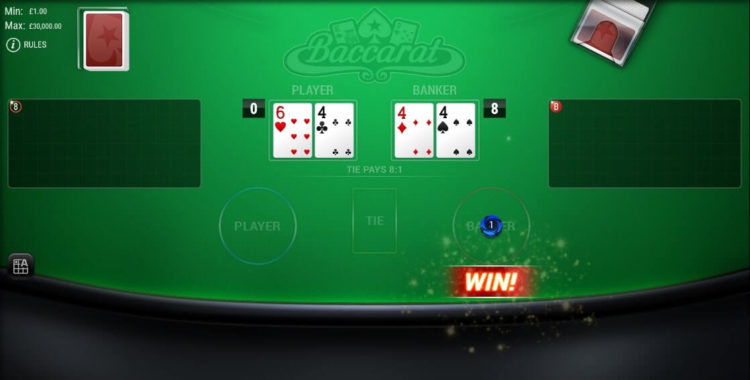
The first mistake casino players make about baccarat is that it’s a sophisticated game for high rollers. That couldn’t be further from the truth because baccarat is probably the easiest of all casino games, except maybe slots. And when you play online, you can play at just about any stakes you like.
With no tough decisions to make and no scary swings to worry about, it is also a game that is relaxing. So, kick back and read more about how to play baccarat. It’s James Bond’s favorite game, so you’ll be in good company.
How to Play Baccarat
We meant it when we said there is no decision-making in baccarat. All you must do is choose whether to bet on Banker, Player, or Tie. And that’s it. The dealer plays the hand out to its conclusion while you watch on, and if you win, you match your bet with profit. If you lose, you lose your bet.
This simple two-way result, with occasional ties, means there is a low house edge in baccarat, too. It can be as low as 1%, one of the lowest of all casino games, meaning for every $100 you bet, you are only expected to lose $1. Of course, you can go on a mini winning or losing streak in the short term, but this house edge will play out in the long term. You should note that this house edge is more enticing than, say, American Roulette, which is 5.25%.
So how does a round of baccarat (called a coup) play out? It’s easy to try this at an online casino where you can take your time and not worry about anyone judging what you are doing. Be sure to pick a trustworthy platform like Wild Casino – this review will tell you all you need to know, but there are lots of alternatives out there.
Once you are sat down at your virtual table, you must make that one-and-only decision, whether to back the Banker hand, the Player hand, or whether you think it will be a Tie.
Once you have placed your bet, the dealer will deal two cards face-up in the Player and then the Banker section. The winning hand is where the face-value total of the cards is closest to nine. When the total of the two cards goes over nine, the first number of the total is dropped. So, 13 becomes 3, or 17 becomes 7. Picture cards are value 0, and the aces are 1.
There are some complexities when it comes to the dealer producing a third card or not. These are produced below, but during the game, the dealer makes this decision, so you need not worry about it.
The Player’s rule
- If the Player draws 0-5, they take a third card
The Banker’s rule
- If the Player used only two cards, the Banker can draw again on 5 or fewer
- If the Banker total is 2 or fewer, he draws a third card
- If the Banker total is 3, then the Banker draws again unless the Player’s third card was 8
- If the Banker total is 4, then he draws again if the Player’s third card was 2, 3, 4, 5, 6, 7
- If the Banker total is 5, then he draws again if the Player’s third card was 4, 5, 6, 7
- If the Banker total is 6, then he draws again if the Player’s third card was 6, or 7
- If the Banker total is 7, the Banker stands.
And that is all there is to it. After these cards are drawn, the relative totals are summed up, and the winner is the one with the total closest to 9 – or a tie.
The Biggest Baccarat Tip
We’ve already discussed how the house edge in baccarat is one of the lowest in the casino, whether you play online or visit a new brick-and-mortar casino. But actually, there is a tiny difference in the house edge between betting on Player or Banker. Because of the Banker drawing rules, there is a wafer-thin advantage on backing Banker over time. So, to maximize your profits, you should always place your bets in the Banker section.
Of course, casino players are fickle. If the Banker has won the previous four rounds, some players will reason they should bet on the Player next time because that is bound to win. However, that is something called the “gambler’s fallacy” – assuming something will happen based on the most recent run of results.
The point is, every new round has exactly the same odds as the previous one, so you should keep backing Banker. To put it in simpler terms, if you tossed a coin twice and it came up heads both times, it does not make it more likely that it will be tails on a third toss – because the third toss starts with the same 50/50 odds as the previous two! And before anyone complains, we know some people claim there are more like 51/49 odds in coin tossing, depending on which way up the coin was at the start!
- Comprehensive Guide to the Board Game Go (weiqi, baduk) - January 23, 2024
- Are Creative Suites Changing Gaming - October 30, 2023
- Crowning the Kings of Solitaire: GameRules Recognizes Solitaired and MobilityWare as top Solitaire Games - October 20, 2023